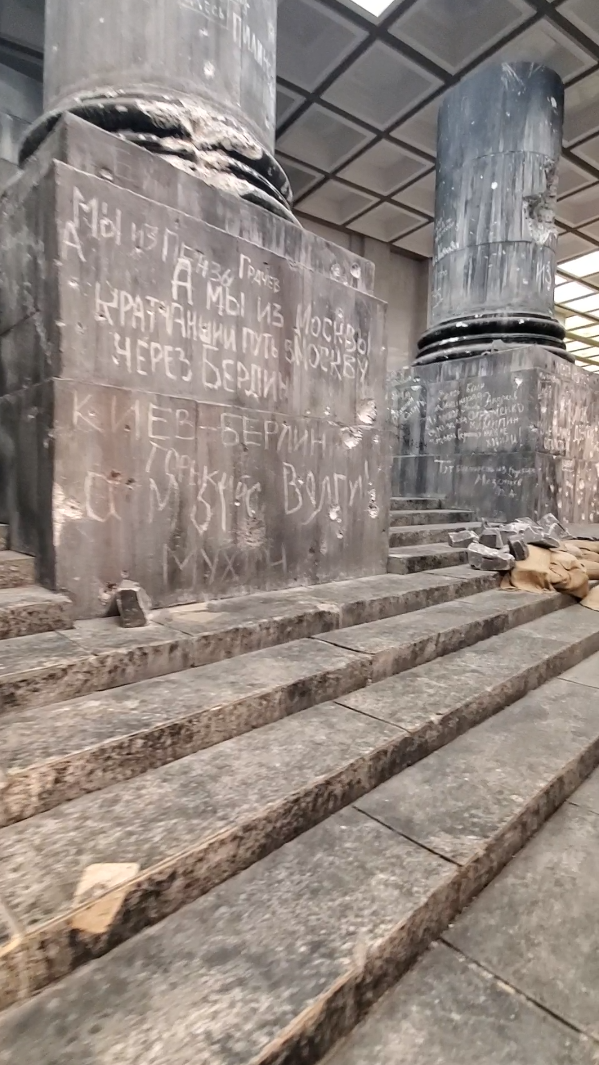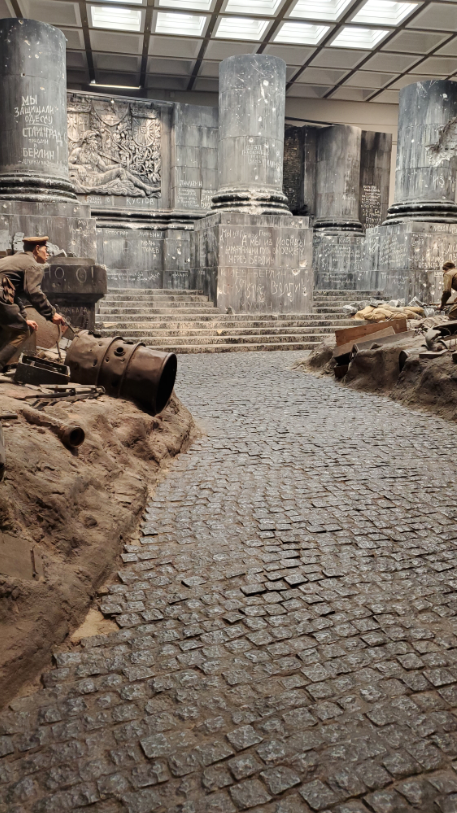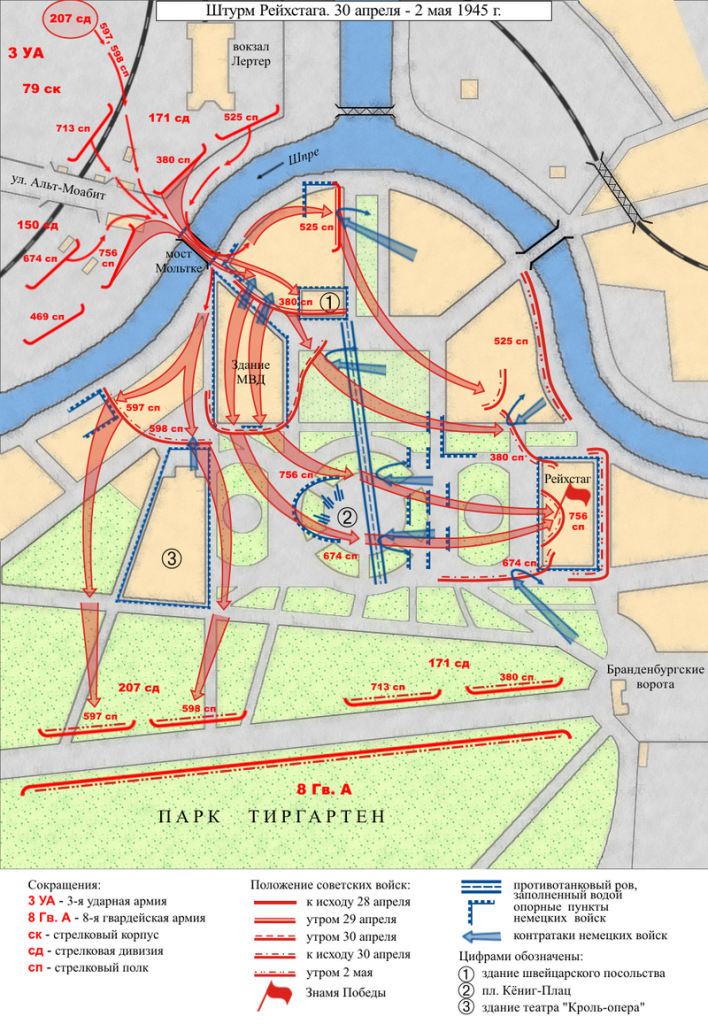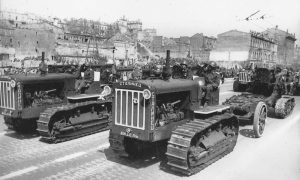The Battle For the Reichstag WW2:
28 April 1945
By the evening of April 28, units of the 79th Rifle Corps of the 3rd Shock Army occupied the area from the northwest approached the area where, in addition to the Reichstag, the building of the Ministry of the Interior, the Kroll Opera theater, the Swiss embassy and a number of other structures were located. Well fortified and adapted for long-term defense, together they constituted a powerful node of resistance.
Another water barrier lay in front of the advancing troops – the Spree River. Its three-meter reinforced concrete banks excluded the possibility of crossing on improvised means. The only way to the south bank was through the Moltke Bridge, which, when the Soviet units approached, was blown up by German sappers, but did not collapse, but only deformed. At both ends, the bridge was covered with reinforced concrete walls one meter thick and about one and a half meters high. It was not possible to capture the bridge on the move, since all approaches to it were shot through with multi-layered machine-gun and artillery fire. It was decided to re-assault the bridge after careful preparation. Powerful artillery fire destroyed the emplacements in the buildings on the Kronprinzen-ufer and Schlieffen-ufer embankments and suppressed the German batteries that were shelling the bridge.
April 29 1945
By the morning of April 29, the forward battalions of the 150th and 171st Infantry Divisions under the command of Captain S. A. Neustroev and Senior Lieutenant K. Ya. Samsonov crossed over to the opposite bank of the Spree.
After the crossing, the Soviet units started fighting for the block located southeast of the Moltke Bridge. Among other buildings in the quarter was the building of the Swiss embassy, which faced the square in front of the Reichstag and was an important element in the general system of German defense. On the same morning, the building of the Swiss embassy was cleared of the enemy by the companies of Senior Lieutenant Pankratov and Lieutenant M.F. Grankin. The next target on the way to the Reichstag was the building of the Ministry of the Interior, nicknamed by the Soviet soldiers “Himmler’s House”. It was a huge six-story building that occupied an entire block. The solid stone building was additionally adapted for defense. A powerful artillery preparation was carried out to capture Himmler’s house at 7 o’clock in the morning,immediately after which the Soviet soldiers rushed to storm the building. The next day, units of the 150th Infantry Division fought for the building and by dawn on April 30 captured it. The way to the Reichstag was open.


April 30 1945
Before dawn on April 30, the following situation developed in the combat area. The 525th and 380th Regiments of the 171st Infantry Division fought in the quarters north of Königplatz Square. The 674th regiment and part of the forces of the 756th regiment were engaged in cleaning the building of the Ministry of Internal Affairs from the remnants of the garrison. The 2nd battalion of the 756th regiment went to the moat and took up defenses in front of it. The 207th Infantry Division was crossing the Moltke Bridge and preparing to attack the Croll Opera building.
The Reichstag was a real fortress. The windows and doors of the building were filled with red bricks, and loopholes were left in the masonry for machine-gun fire. From north to south, the Königplatz square was crossed by a pit of the metro line, filled with water. In front of the facade of the Reichstag, four batteries of 105 mm and one of 88 mm guns were placed for direct fire. The defenders were supported by artillery units, tanks and assault guns located in the Tiergarten park and at the Brandenburg Gate. The area of the Reichstag was defended by a garrison of 5,000.
An attempt to seize the Reichstag on the move on the morning of April 30 was unsuccessful. The attack of units of the 756th and 674th regiments was repelled by heavy fire from the Reichstag and the Kroll Opera.
The second assault was scheduled for 13:00. Infantry actions were to be preceded by a 30-minute artillery preparation. For its implementation, all artillery of the 674th and 756th regiments of the 150th rifle division, part of the artillery of the 171st rifle division and several artillery units of corps subordination were allocated. By this time, Soviet sappers cleared and reinforced the damaged Moltke Bridge so that it could withstand heavy equipment. Some of the guns and tanks were transported to the southern bank of the Spree and aimed directly at the Reichstag. 89 barrels were delivered to direct fire alone. They were to play a major role in the destruction of fortifications and the suppression of emplacements in the Reichstag. There was not enough free and relatively safe space to accommodate such a number of fire weapons, so some of the artillery had to be dragged to the second floor of the Ministry of Internal Affairs building. If necessary, the entire artillery of the 79th Rifle Corps – over 1000 barrels – could be involved in suppressing enemy fire resources. All the while the preparations and the assault on the Reichstag were going on, fierce battles were fought on the right flank of the 150th Infantry Division in the zone of the 469th Infantry Regiment. Having taken up defenses on the right bank of the Spree, the regiment fought off numerous German attacks for several days, aimed at reaching the flank and rear of the troops advancing on the Reichstag. Artillerymen played an important role in repelling German attacks. In these battles, the commander of a fire platoon of artillery of the 469th rifle regiment I.F.Klochkov, who was later awarded the title of Hero of the Soviet Union, distinguished himself.
By noon, rifle subunits, under cover of artillery fire, took up their starting position for the assault. At 13:00, all the guns intended to support the infantry opened fire on the Reichstag, adjacent fortifications and firing points. Taking part in the general artillery preparation, tanks of the 23rd tank brigade, 85th tank regiment and 88th heavy tank regiment fired at the Reichstag. Parts of the 207th Infantry Division with their fire suppressed the firing points located in the building of the Kroll Opera, blocked its garrison and thereby facilitated the assault. Under the cover of artillery barrage, battalions of the 756th and 674th rifle regiments went over to the attack and, on the move, overcoming the moat filled with water, engaged in a battle in trenches and trenches in front of the Reichstag.

Storming Reichstag Map
At 14:25 on April 30, 1945, Lieutenant Rakhimzhan Koshkarbaev and Private Grigory Bulatov crawled up to the central part of the building on their bellies and attached a red flag to a column near the stairs of the main entrance. V.M.Shatilov recalls:
… from my position on the fourth floor, it was seen how the figures of people scattered over the square rose, ran, fell, rose again or remained motionless. And all of them were pulled together, as if to two poles of a magnet, to the front door and to the south-western corner of the building, behind which there was a parliamentary entrance hidden from my eyes. I saw how the Banner suddenly glowed with a scarlet speck over the steps at the right column.
According to the recollections of Alexander Bessarab, at the same time through a breach in the northwestern wall of the Reichstag, made by sappers of the 171st Infantry Division, a group of Soviet fighters burst into the building from the north.
We saw our infantry advance from floor to floor inside the Reichstag. Each soldier had a red flag or some piece of red rag with him to show “there is a flag here”, “there is a flag here” (that is, they designated the captured floors in this way).
– Alexander Bessarab, participant in the Battle of Berlin and the capture of the Reichstag
Late in the evening of April 30, 1945, the 1st battalion of the 756th rifle regiment under the command of Captain S.A. Neustroev, the 1st battalion of the 674th rifle regiment under the command of Captain V.I.Davydov and the 1st battalion of the 380th rifle regiment under the command of senior lieutenant K. Ya. Samsonov captured the main part of the Reichstag. Separate groups under the command of Major MM Bondar and Captain VN Makov, tankmen of the 23rd Tank Brigade also took part in the assault on the building.
On the evening of April 30, an assault group consisting of senior sergeants M.P. Minin, G.K. Zagitov, A.F. Lisimenko and sergeant A.P. Bobrov under the command of Captain V.N.Makov broke into the Reichstag building. Unnoticed by the enemy, they found a locked door and knocked it out with a log; Having climbed to the attic, the group made their way through the dormer window to the roof above the western (front) pediment of the building. At 22 hours 40 minutes, they installed the Red Banner in the hole in the crown of the sculpture of the Goddess of Victory …
Having lost the upper floors, the Germans took refuge in the basement and continued their resistance, hoping to break out of the encirclement, cutting off the Soviet soldiers in the Reichstag from the main forces.
The 1st of May 1945

Early in the morning of May 1 Lieutenant A. P. Berest, Sergeant M. A. Egorov and Junior Sergeant M. V. Kantaria, with the support of the machine gunners of the company I. A. Syanov, hoisted the assault flag of the 150th Infantry Division over the Reichstag, which later became the Banner of Victory.
At 10 o’clock in the morning on May 1, German troops launched a coordinated counterattack from outside and from within the Reichstag. From the Brandenburg Gate, the positions of the 674th regiment attacked up to 300 Nazis with the support of a dozen tanks. At the same time, the German units that remained in the Reichstag went over to the attack. From the explosions of the faust cartridges, a fire broke out in several places of the building, which soon engulfed the entire first floor. Soviet soldiers had to fight the enemy and fight fire at the same time.
All around the smoke, smoke, smoke. It swayed in the air in black waves, enveloping halls, corridors, rooms with an impenetrable veil. Only a small fraction of the smoke escaped. Clothes smoldered in people, burned hair, eyebrows, spiral breath.
When we were almost knocked out of the Reichstag, we lingered on the last meters, there inside. He was set on fire: the left side was on fire. We have 12 wounded burned down and suffocated there. The situation was critical.
– Vasily Ustyugov, participant of the Berlin battle
The battle in the burning building continued until late in the evening. Only after a successful attack to the rear of the German units did the soldiers of S.A.Neustroev manage to drive the Nazis into the basement. Realizing the senselessness of further resistance, the command of the Reichstag garrison proposed to begin negotiations on the condition that an officer with the rank of colonel at least should take part in them from the Soviet side. Among the officers who were at that time in the Reichstag, there was no one older than the major, and communication with the regiment did not work. Therefore, it was decided to send a tall and representative lieutenant to negotiations, having previously disguised him in the uniform of a colonel. After a short preparation, A. Berest went to the negotiations as a colonel, S. A. Neustroev as his adjutant and private I. Prygunov as an interpreter. The negotiations began with a proposal by A.Birch bark about surrender. In response, the German the parliamentarians announced the readiness of the garrison to lay down their arms, but on condition that the Soviet soldiers leave the firing positions. They explained their condition with the fear that the Red Army men, flushed by the battle, would inflict lynching on the surrendering. The Soviet “colonel” categorically rejected this proposal and demanded unconditional surrender. After that, the Soviet delegation left the basement. Only in the early morning of May 2 did the German garrison surrender.
On the opposite side of the Königplatz square, the battle for the building of the Kroll Opera theater was going on all day on May 1. Only by midnight, after two unsuccessful assault attempts, the 597th and 598th regiments of the 207th rifle division took possession of the theater building and hoisted over it the red flag received from the Military Council of the 3rd Shock Army. From the garrison of the Kroll Opera, 850 German soldiers and officers surrendered.














